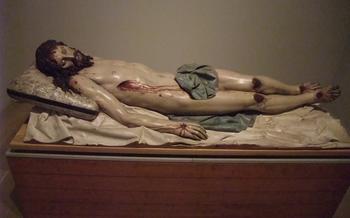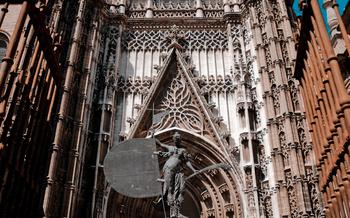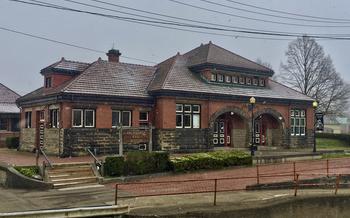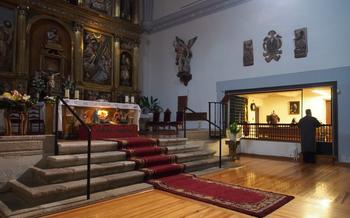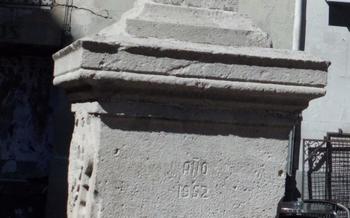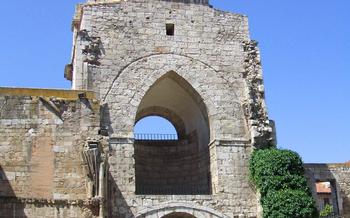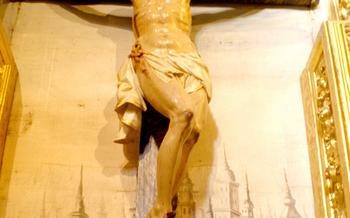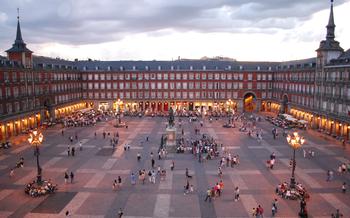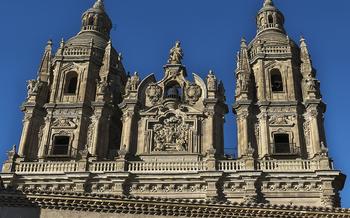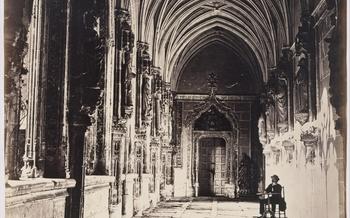
Museo del Monasterio de Santa Isabel
- Exploring the History of Valladolid through the Museum
- The Monasterio de Santa Isabel: A Majestic Architectural Gem
- Renaissance and Baroque Art in the Museum's Collection
- Religious Art and Iconography in the Museum
- Practical Tips for Visiting the Museum
- The Museum's Collection of Sculptures
- The Museum's Collection of Paintings
- Interactive Exhibits and Multimedia Presentations
- Guided Tours of the Museum
- Accessibility for Visitors with Disabilities
- Insider Tip: Hidden Gems of the Museum
Exploring the History of Valladolid through the Museum
Valladolid, situated in the heart of Castile and León, boasts a rich and captivating history dating back to the Middle Ages. The Museo del Monasterio de Santa Isabel serves as a repository of the city's storied past, providing visitors with an immersive journey through the annals of Valladolid.
One of the museum's most significant contributions lies in its ability to shed light on the city's transformation from a humble medieval settlement to a thriving center of trade and culture. Through its collection of artifacts, documents, and interactive exhibits, the museum narrates the tales of Valladolid's monarchs, its role in the Spanish Inquisition, and its flourishing during the Renaissance and Baroque periods.
Visitors can marvel at ancient maps depicting the city's evolution, examine letters and manuscripts that reveal the thoughts and aspirations of its inhabitants, and engage with multimedia presentations that bring the past to life. The museum's historical artifacts and interactive displays offer a multidimensional exploration of Valladolid's rich tapestry of events, personalities, and traditions.
Step into the Museo del Monasterio de Santa Isabel and embark on a captivating journey through the vibrant history of Valladolid, a city that has played a pivotal role in shaping the cultural and political landscape of Spain.
The Monasterio de Santa Isabel: A Majestic Architectural Gem
io de Santa Isabel, a stunning architectural masterpiece that stands as a testament to Valladolid's rich history. The monastery was founded in the 15th century by Isabel la Católica, Queen of Castile and León, as a royal convent for the Franciscan order. Over the centuries, it underwent several renovations and expansions, resulting in a harmonious blend of architectural styles, from Gothic to Renaissance and Baroque.
The exterior of the monastery is characterized by its imposing façade, featuring a grand entrance adorned with intricate carvings and sculptures. The interior boasts a spacious cloister with graceful arches and a serene fountain at its center. Visitors can explore the various chapels, each showcasing unique architectural elements and housing valuable religious artworks.
The most remarkable feature of the monastery is its church, a breathtaking example of Gothic architecture. The soaring nave, supported by elegant columns, leads to an elaborate altar decorated with intricate carvings and paintings. The stained glass windows, depicting scenes from the Bible and the lives of saints, bathe the interior in a kaleidoscope of colors, creating an awe-inspiring atmosphere.
A visit to the Museo del Monasterio de Santa Isabel offers a journey through time, allowing visitors to admire the architectural splendor of the monastery while delving into the rich history of Valladolid.
Renaissance and Baroque Art in the Museum's Collection
The Museo del Monasterio de Santa Isabel boasts an impressive collection of Renaissance and Baroque art, showcasing masterpieces that reflect the artistic brilliance of these eras. Visitors can marvel at the intricate details, vibrant colors, and expressive forms that characterize these works.
Among the highlights of the Renaissance collection are delicate sculptures by Alonso Berruguete, whose mastery of anatomy and movement brings biblical figures to life. Visitors can also admire the serene and harmonious paintings of Juan de Juanes, which capture the essence of the Italian Renaissance style with their soft, natural light and elegant compositions.
The Baroque period is equally well-represented, with dynamic and dramatic works that embrace movement, emotion, and theatricality. Visitors can stand in awe before the powerful sculptures of Gregorio Fernández, which convey intense religious fervor and suffering through their expressive gestures and intricate details. The museum also houses notable Baroque paintings by Francisco de Zurbarán, whose use of chiaroscuro and dramatic lighting creates a sense of mystery and contemplation.
The museum's collection is organized both thematically and chronologically, allowing visitors to trace the evolution of artistic styles and techniques from the early Renaissance to the late Baroque period. Whether you're an art enthusiast or simply appreciate the beauty of these historical works, the Museo del Monasterio de Santa Isabel offers a captivating journey through the artistic achievements of these remarkable eras.
Religious Art and Iconography in the Museum
The Museo del Monasterio de Santa Isabel is a treasure trove of religious art, reflecting the deep-rooted Catholic faith and artistic traditions of Spain. The collection features a diverse range of religious artworks, from intricate altarpieces and sculptures to paintings depicting biblical scenes and saints.
Common iconographic motifs and symbols in religious artwork include the cross, the dove, the lamb, and the lily. These symbols often carry deep spiritual and allegorical meanings, representing concepts such as salvation, purity, and sacrifice.
The museum's collection showcases the evolution of religious art styles over the centuries, from the Gothic period to the Renaissance and Baroque eras. Gothic art is characterized by its elongated figures, intricate details, and vibrant colors, while Renaissance art emphasizes realism, perspective, and humanism. Baroque art, on the other hand, is known for its dramatic lighting, emotional intensity, and elaborate ornamentation.
Visitors can trace the development of religious beliefs and practices in Spain through the museum's collection. The artworks provide insights into the lives of saints, the rituals of the Catholic Church, and the role of religion in shaping Spanish culture and history.
Practical Tips for Visiting the Museum
To make the most of your visit to the Museo del Monasterio de Santa Isabel, here are a few practical tips:
-
Best time to visit: Aim to visit during the off-season (November to March) or on weekdays to avoid crowds and fully appreciate the tranquility of the museum.
-
Navigating the museum: The museum is well-organized, with clear signage and maps to help you find your way around. However, if you're short on time, focus on the highlights, such as the main cloister, the church, and the museum's temporary exhibitions.
-
Must-see highlights for a short visit: If you have limited time, prioritize seeing the following: the Isabelline Gothic altarpiece in the church, the Renaissance-style cloister, and the museum's collection of paintings by Spanish masters, including El Greco and Francisco de Goya.
-
Accessibility features: The museum is wheelchair accessible, with ramps and elevators throughout the building. Additionally, the museum offers special programs and services for visitors with disabilities, including assistive devices and audio guides for the visually impaired.
The Museum's Collection of Sculptures
The Museo del Monasterio de Santa Isabel boasts a remarkable collection of sculptures that spans different periods and styles, from Gothic to Baroque. These three-dimensional works of art add depth and dimension to the museum's exhibits, providing visitors with a comprehensive understanding of the artistic and cultural heritage of Valladolid.
Among the notable sculptures in the collection is a poignant depiction of the Pietà, carved in the 16th century. The intricate details and lifelike expressions convey the profound grief of the Virgin Mary as she holds the body of her son, Jesus Christ, after his crucifixion. The sculpture is a testament to the skill and artistry of the Spanish sculptors of the Renaissance period.
Another highlight of the collection is a majestic sculpture of Saint John the Baptist, created in the Baroque style during the 17th century. The dynamic posture and expressive gestures of the saint, combined with the intricate folds of his drapery, showcase the virtuosity of the Baroque sculptors.
The museum also houses a collection of Gothic sculptures, characterized by their elongated proportions and intricate details. These works, dating back to the 13th and 14th centuries, offer a glimpse into the early artistic traditions of Valladolid.
The materials used in the sculptures vary, with wood, stone, and polychrome being the most common. The skillful manipulation of these materials by the artists results in sculptures that are both aesthetically pleasing and technically impressive.
The themes and subjects explored in the sculptures are diverse, ranging from religious iconography to mythological figures. Visitors can admire representations of saints, angels, and biblical scenes, as well as mythological creatures and allegorical figures.
The evolution of sculpture styles from Gothic to Baroque is evident in the museum's collection. The Gothic sculptures are characterized by their elongated proportions, rigid poses, and attention to detail, while the Baroque sculptures exhibit a more dynamic and expressive style, with exaggerated gestures and intricate ornamentation.
The Museum's Collection of Paintings
The Museo del Monasterio de Santa Isabel boasts an impressive collection of paintings that spans different artistic periods, from the Renaissance to the Baroque. Visitors can admire the works of renowned Spanish masters such as Pedro Berruguete, Juan de Flandes, and Gregorio Fernández.
Famous Paintings in the Collection:
-
Pedro Berruguete's Retablo de San Benito: This magnificent altarpiece features intricate carvings and vibrant colors, depicting scenes from the life of Saint Benedict.
-
Juan de Flandes' Pietà: A poignant portrayal of the Virgin Mary cradling the body of Christ after the crucifixion, known for its emotional intensity and realism.
-
Gregorio Fernández's Ecce Homo: A powerful sculpture depicting Christ crowned with thorns, capturing the suffering and sacrifice of the Savior.
Techniques and Styles:
-
Tempera on Wood: Many early paintings in the collection are executed in tempera on wood, a technique that involves using egg yolk as a binder for pigments.
-
Oil on Canvas: Later works from the Baroque period showcase the mastery of oil on canvas, allowing for richer colors and more detailed brushwork.
Themes and Subjects:
-
Religious Themes: The majority of the paintings in the collection have religious themes, reflecting the strong influence of the Catholic Church during the time of their creation.
-
Historical and Mythological Themes: Some paintings depict historical events or mythological scenes, offering a glimpse into the cultural and intellectual interests of the period.
Conservation and Restoration:
The museum is committed to preserving and restoring its collection of paintings. Visitors may encounter ongoing conservation work, highlighting the efforts to protect and maintain these valuable artworks for future generations.
Interactive Exhibits and Multimedia Presentations
The Museo del Monasterio de Santa Isabel takes a forward-thinking approach to engaging visitors of all ages through interactive exhibits and captivating multimedia presentations. These innovative tools enhance the museum experience, making it both educational and entertaining. Visitors can interact with touchscreens to explore the history of the monastery and the city of Valladolid, or use virtual reality goggles to step back in time and experience life in the monastery during the Renaissance period. Multimedia presentations bring the museum's collection to life, with high-definition videos and immersive audio guides providing additional insights into the artworks and historical artifacts on display. The museum's commitment to innovative educational tools ensures that visitors leave with a deeper understanding and appreciation for the cultural heritage of Valladolid.
Guided Tours of the Museum
Taking a guided tour of the Museo del Monasterio de Santa Isabel is an excellent way to delve deeper into the museum's history, art, and architecture. Knowledgeable and passionate guides bring the exhibits to life, sharing insights and anecdotes that enhance the visitor experience.
The museum offers a variety of guided tours tailored to different interests and schedules. Standard tours provide a comprehensive overview of the museum's highlights, while thematic tours focus on specific aspects such as Renaissance art, religious iconography, or the history of the monastery. Private tours are also available for groups or individuals seeking a more personalized experience.
To book a guided tour, visitors can contact the museum in advance by phone or email. Reservations are recommended, especially for groups and during peak tourist season. Guided tours are typically conducted in Spanish, but English-language tours can be arranged upon request.
Whether you're an art enthusiast, a history buff, or simply curious to explore one of Valladolid's cultural gems, the Museo del Monasterio de Santa Isabel offers guided tours that cater to every interest.
Accessibility for Visitors with Disabilities
The Museo del Monasterio de Santa Isabel is committed to ensuring that all visitors, regardless of their abilities, can enjoy the museum's treasures. Wheelchair accessibility and ramps are available throughout the museum, allowing visitors with limited mobility to navigate the galleries and exhibits with ease. In addition, the museum offers special programs and services for visitors with disabilities, such as guided tours in sign language and audio guides for the visually impaired. Visitors with disabilities are also entitled to discounted admission fees. Designated parking spaces are available for visitors with disabilities, making it easy and convenient to visit the museum. With its commitment to inclusivity, the Museo del Monasterio de Santa Isabel strives to create a welcoming and accessible environment for all visitors.
Insider Tip: Hidden Gems of the Museum
Beyond the renowned masterpieces, the Museo del Monasterio de Santa Isabel hides a treasure trove of lesser-known gems that are waiting to be discovered. For those seeking tranquility, the cloister garden offers a serene oasis, where visitors can find respite from the bustling city. This hidden sanctuary, adorned with delicate flowers and trickling fountains, invites contemplation and reflection.
For art enthusiasts, the museum's collection boasts several hidden masterpieces tucked away in unexpected corners. The small chapel, off the main gallery, houses a stunning altarpiece by a local artist, whose intricate carvings and vibrant colors rival those of more famous masters. The museum's collection of medieval manuscripts also contains hidden treasures, such as illuminated pages with exquisite calligraphy and intricate illustrations that transport visitors back in time.
To capture the essence of the museum's charm, venture to the rooftop terrace, which offers breathtaking panoramic views of Valladolid. From this vantage point, visitors can admire the city's architectural tapestry, with its historic spires and terracotta rooftops, while enjoying the gentle breeze and warm Spanish sun.
After immersing yourself in the museum's treasures, indulge in a delightful treat at the museum's café. Located in the former refectory of the monastery, the café offers a menu inspired by traditional Spanish cuisine, using fresh, local ingredients. Savor the flavors of Spain as you recount your discoveries and reflect on the hidden gems you unearthed during your visit to the Museo del Monasterio de Santa Isabel.
